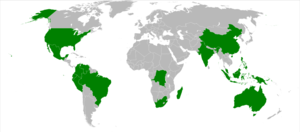

1 - Tropical Andes
5 - Tumbes-Chocó-Magdalena

The biodiversity of Colombia is the variety of indigenous organisms in the country with the second-highest biodiversity in the world.[1] As of 2021, around 63,000 species are registered in Colombia, of which 14% are endemic. The country occupies worldwide the first position in number of orchids, birds and butterflies, second position in plants, amphibians and fresh water fish, third place in species of palm trees and reptiles and globally holds the sixth position in biodiversity of mammals.[2]
The country hosts 59 nationally designated protected areas. At the establishment of the most recent addition, Bahía Portete – Kaurrele National Natural Park, Colombian president Juan Manuel Santos said "Biodiversity is to Colombia, what oil is for the Arabs".[3][4]
In 2020, according to the Colombian Biodiversity Information System, 63,303 species were registered in the country,[5] of which more than 8,800 are considered endemic species.[6][7][8] The country occupies the first position in the world in number of orchid and bird species, second in plants, amphibians, butterflies and freshwater fish, third in palm and reptile species, and fourth in mammalian biodiversity.
According to a report by the WWF, half of Colombia's ecosystems are in a critical state of deterioration or in a state of danger. The organization said that environmental degradation is due to oil extraction, mineral and metal extraction and deforestation. Deteriorating ecosystems are threatening the existence of more than a third of Colombia's plants and 50 percent of its animals.[9]
Since 1998, the Humboldt Institute for Biological Resources has been collecting biodiversity samples. As of 2014, 16,469 samples, representing around 2,530 species of 1,289 genera, and 323 families from Colombian biodiversity have been stored in its archives. [10]
- ^ Cite error: The named reference
HumboldtBiowas invoked but never defined (see the help page). - ^ Cite error: The named reference
SiB_homewas invoked but never defined (see the help page). - ^ Nuevo Parque Nacional Natural de Colombia Bahía Portete[permanent dead link] - Ministerio de Ambiente, Colombia (in Spanish)
- ^ Bahía Portete, regalo de Navidad - El Espectador (in Spanish)
- ^ Biodiversidad en Cifras 2021 - SiB Colombia (in Spanish)
- ^ Especies endémicas, áreas protegidas y deforestación | Biodiversidad 2018 - Humboldt Institute (in Spanish)
- ^ Cite error: The named reference
BioDivAZwas invoked but never defined (see the help page). - ^ Cite error: The named reference
SIACwas invoked but never defined (see the help page). - ^ Colombia Viva:Informe 2017 - WWF-Colombia
- ^ "Instituto Humboldt". www.humboldt.org.co (in European Spanish). Retrieved 2021-06-08.
